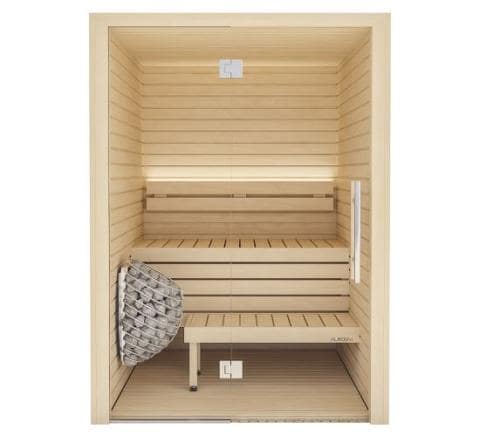About Traditional Sauna
About Traditional Sauna
Blog Article
Traditional Sauna - The Facts
Table of ContentsNot known Facts About Traditional SaunaThe Buzz on Traditional SaunaTraditional Sauna Can Be Fun For EveryoneWhat Does Traditional Sauna Do?
The majority of the weight lost in a sauna is water loss and is re-gained upon rehydrating. Without an uncertainty sauna can be a vital component of a healthy weight loss program. To take a look at the distinctions in between standard and IR saunas, I will separate these right into verifiable, theoretical, and produced differences.Hence, the most popular factor in the saunawhich is at the ceiling straight above the sauna heateris usually between 185 and 190 F. Traditional Sauna. Claims that a conventional sauna surpasses 200 F is just not real and not appropriate for electrical saunas sold in the US. The temperature for a far-infrared sauna is normally established in between 120 and 140 F; nevertheless, unlike the conventional sauna, the objective in and IR area is not to achieve a heat
Due to this, the temperature level difference is virtually unimportant, given that profuse sweating leads to both sauna types, however the technique of heating the body is different. In an IR sauna the bather will feel warm and will certainly sweat a lot, yet at much lower temperature levels. Therefore, if the objective is to spend longer durations of time in the sauna, the IR sauna is an excellent choice.

Traditional Sauna - The Facts
When the heat is attained, the aspects cycle on and off to keep the high temperature level. A lot of typical sauna customers appreciate putting water over the rocks to create vapor to raise sauna humidity levels. The benefits of putting water over the rocks include: making the room much more comfy, moistening the nasal flows, and allowing the usage of aromatherapy by blending essential oils with the water.
In a far-infrared sauna, the warm front permeate the body to properly heat the body and raise the body core temperature level. To achieve this enhanced temperature, Far-infrared emitters produce infrared energy which is close to the very same wavelength as that click to investigate which the body naturally emitsoften described as the "Important Array" of 7 to 14 microns), so the power is well received by the body.
When the energy gets in the body, it causes the body temperature to enhance and ultimately leads to sweating. In an infrared sauna it is very important for the emitters/heaters to remain on virtually regularly. Since there is no mass of rocks to maintain warm, the sauna will certainly cool if the emitters shut down.
As stated above, the sauna bather in an infrared room intends to position himself in front of running emitters to get optimal take advantage of the warmth. The heating time for both areas can be really different, depending on how the rooms are utilized. For a traditional sauna, a bather must enable 30-40 minutes for the room to achieve a wanted temperature and to appropriately pre-heat the rocks.
Traditional Sauna Can Be Fun For Anyone
A well created sauna will generally attain a temperature of 150-160 F in regarding Look At This 30-40 minutes. For hotter temperatures, the area may need to heat for a longer duration.
To some, 15 minutes was "thrown away" while the infrared energy heated up the wood panels as opposed to warming a body, while others locate a pre-heated room to be a lot more comfortable and think a raised starting temperature level is necessary to begin perspiring. The size of advised use for each and every space is around the very same (10-15 mins per session); however, because of the lower air temperature levels and the capacity to feel the impacts of infrared warmth much faster than a standard sauna, it is not uncommon for a person to spend an overall of 20-30 mins in an infrared sauna.
Standard saunas have a tendency to be larger (for this reason use more electrical energy) than infrared saunas, although typical saunas are definitely available in one and two person sizes too. For a two-person standard sauna, 5x6 or 5x7 size is most popular. The top bench can easily seat 2 or three individuals and is also enough time to relax during the sauna session.


The ordinary cost per kWH of power in the U.S. is roughly $0.11, so a 4.5 kW heating unit will set you back approximately $.50 to run for one hour, if the heating system runs continually for one hour. Typically a sauna heater will run for 75% of the first hour and 50% of subsequent hours article on because the elements cycle once the established temperature level is achieved.
The Best Strategy To Use For Traditional Sauna
A 2 person far-infrared room is typically literally smaller than a conventional sauna, commonly concerning 4' x 4' or smaller sized. The IR heating system is usually 1.5-1.7 kW utilizing a 120 volt 15 amp plug-in solution. Since the area can be utilized faster than a sauna area, we will certainly presume the room is made use of for to of an hour including warm up time.
Lastly, there is a seldom talked about distinction in the social experience in between both spaces. While our culture has actually lost several of the social benefit of the standard sauna experience, it can be extremely socially gratifying. From family members time in the sauna, to heart-felt conversations with significant others, to sauna partiesthe traditional sauna experience can bring about intimate interacting socially.
A lot of higher end infrared rooms consist of tinted light therapy, sound systems and full-glass fronts.
Report this page